Excerpts from Jim Conrad's
Naturalist Newsletter
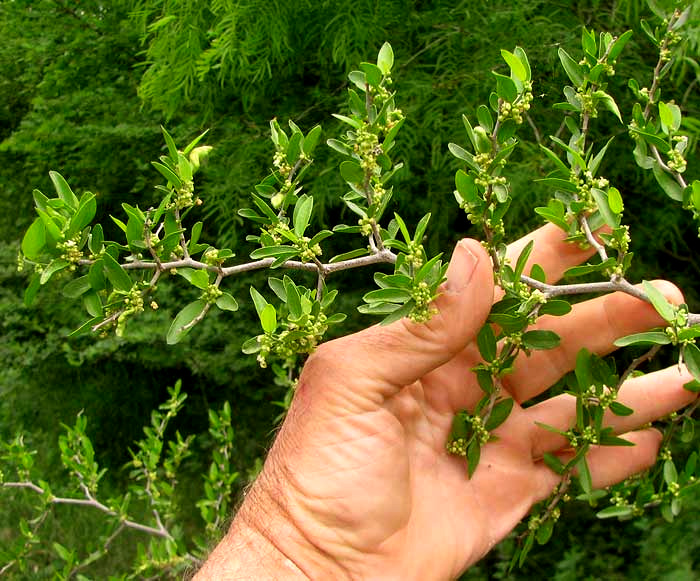
from the April 20, 2014 Newsletter issued from the Frio Canyon Nature Education Center in the valley of the Dry Frio River in northern Uvalde County, southwestern Texas, on the southern border of the Edwards Plateau; elevation ~1750m (~5750 ft); N29.62°, W99.86°; USA
DESERT HACKBERRY FLOWERING
The Desert Hackberry, sometimes called Spiny Hackberry, CELTIS PALLIDA is common in the scrubby forest around Uvalde. A typically zigzagging branch of one about shoulder high, bearing new leaves and flowers, is shown above.
Flowers in the Elm Family, to which hackberries belong, are either unisexual or "hermaphroditic" -- hermaphroditic ones possessing both male and female parts. Hackberry species normally bear both unisexual and hermaphroditic flowers on the same tree, though sometimes the trees are functionally one sex or another. In the above picture the yellowish-green blossoms scattered along the twigs are male flowers consisting of little more than bundles of pollen-producing stamens. However, here and there female flowers do occur, easy to identify because among small and apparently useless stamens rise plump ovaries looking like tiny, green eggs, as seen below:
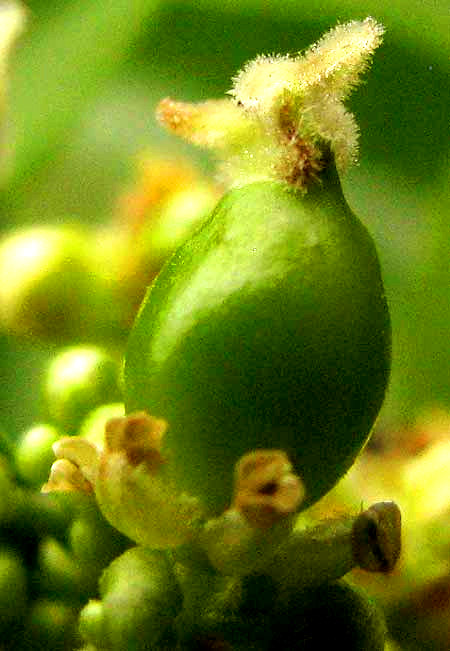
In that picture the fuzzy item atop the ovary is the two-lobed style with hairy stigmatic zones for catching pollen from male hackberry flowers. Those stubby, curved, banana-shaped things below the ovary are vestigial stamens. You can see that this flower bears no corolla; that's a feature of the entire Elm Family. By fall, the ovary will have developed into a sweet, edible, yellow-orange fruit, a drupe, relished by birds.
In fact, the fruits, along with the densely entangling spiny branches, cause Desert Hackberry to be extremely valuable as wildlife food and cover. It's also useful for erosion control, and because of its dense habit can be useful as a landscape screen or informal hedge.
Desert Hackberry leaves don't grow much larger than what's shown above, so relative to other hackberry species Desert Hackberry leaves are exceptionally small. Though the limb in the picture is spineless, Desert Hackberry often bears slender spines. The side branches of the branch in our picture are spinelike, or "spinescent" -- like stout spines bearing leaves and flowers.
Desert Hackberry occurs throughout tropical America from northern Argentina north to southern Texas, New Mexico, Arizona, and Florida, It's likely to show up in grasslands, brushlands and thickets wherever there's gravelly, well-drained, sandy soil, as in deserts, canyons, washes, foothills, washes and the like.
from the July 27, 2014 Newsletter issued from the Frio Canyon Nature Education Center in the valley of the Dry Frio River in northern Uvalde County, southwestern Texas, on the southern border of the Edwards Plateau; elevation ~1750m (~5750 ft); N29.62°, W99.86°; USA
DESERT HACKBERRY FRUITING
Nowadays in the scrub around Uvalde the Desert Hackberries are developing ripe, yellow-orange hackberries, shown below:
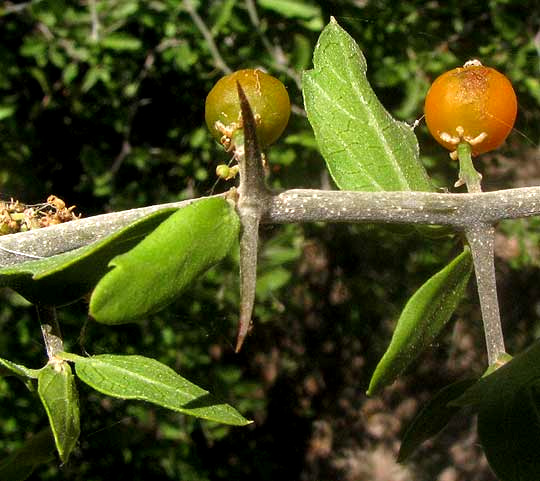
Botanically, hackberry fruits aren't berries. They're drupes, which are fleshy, one-seeded fruits that don't split open when they're ripe, and the seed is enclosed within a stony endocarp. To visualize a seed enclosed within a stony endocarp, think of a peach "seed," which consists of the woody, wrinkled endocarp, which when you break open reveals the actual soft seed inside. The exocarp of the peach is the fleshy part we eat, the same as with hackberries.
entry from November 14, 2021, issued from near Tequisquiapan, elevation about 1,900m (6200 ft), Querétaro state, MÉXICO
DESERT HACKBERRY IN CENTRAL MEXICO
In this cool, arid highland, wherever a dense, tangled copse of low, spiny trees and shrubs occurs, it's a good bet that Desert Hackberry will be represented there. Below, smaller, denser clump occupying the picture's center is a typical plant.
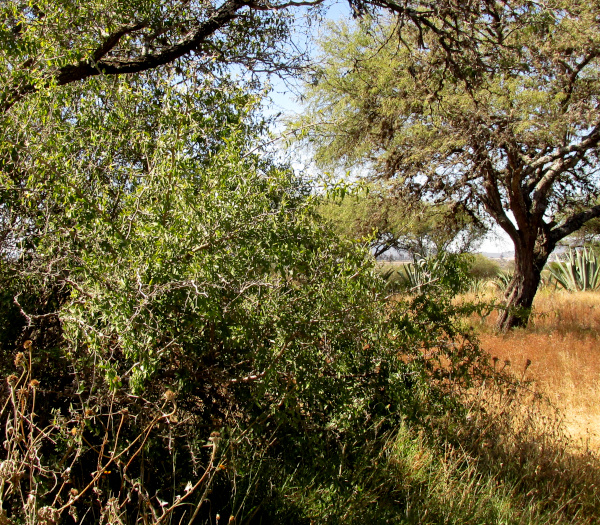
At this season the vast majority of fruits have disappeared. However, a few can still found, like the one shown below, just to convince everyone that this is our familiar Celtis pallida from southwestern Texas.
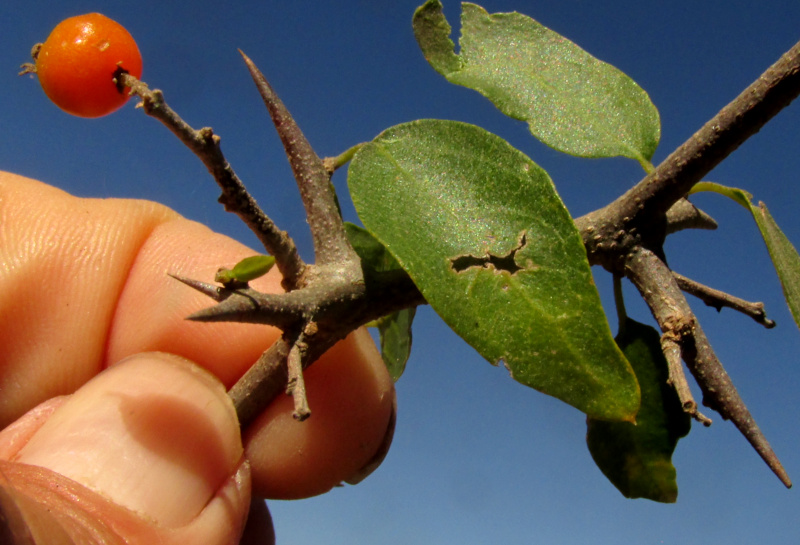
Leaves in that picture and those earlier from Texas have entire margins -- no teeth or lobes -- or close to it. However, on certain shaded and lower branches, leaves are definitely toothed, as seen below:
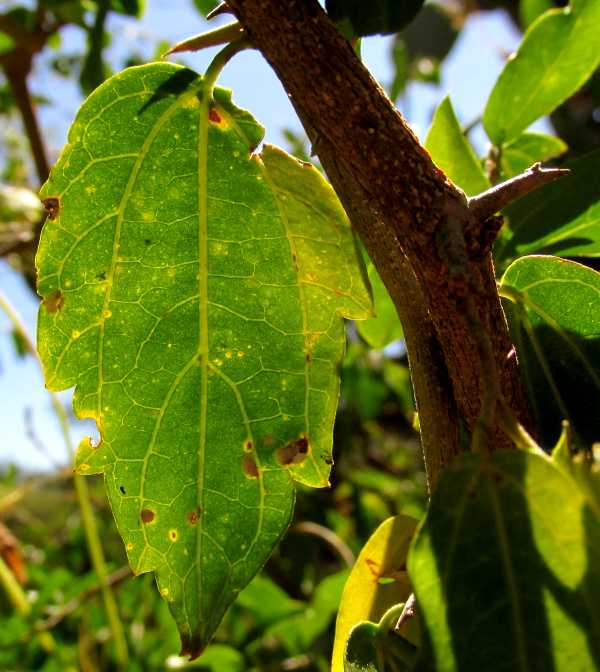
While I was taking these picture, a Northern Mockingbird flew into a nearby tree, not at all hiding, and seemed upset with my presence there. I bet that bird likes Desert Hackberry fruits, and feared that I was taking them away.
entry from August 16, 2022, issued from near Tequisquiapan; elevation about 1,900m, (6200 ft), ~N20.57°, ~W99.89°; Querétaro state, MÉXICO
SEED DISPERSAL BY ANTS
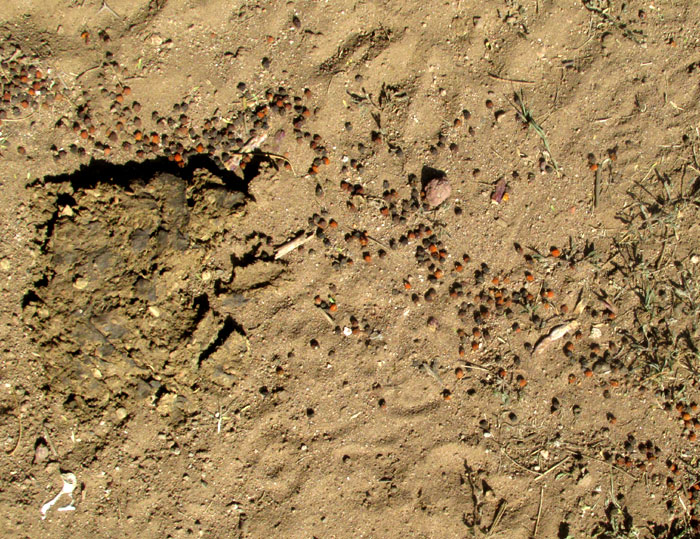
The above was encountered on a narrow, dusty, dirt road through scrub on an overgrazed, eroded, thin-soiled slope, where the rainy season is very late in coming and the whole landscape suffers from drought. In the picture, the brown mass at the left is a dried-up cow paddy, the white objects being mesquite seeds. The many small, spherical, brown and orange items are desiccated fruits from a Desert Hackberry about three meters away (10ft). This is exactly the kind of trail of small, dried fruits harvester ants leave. Harvester ant nests are abundant in this landscape, and ants could be followed from the location in the picture to a nest about 9m upslope (30ft). Here's one of the ants working on a fruit:
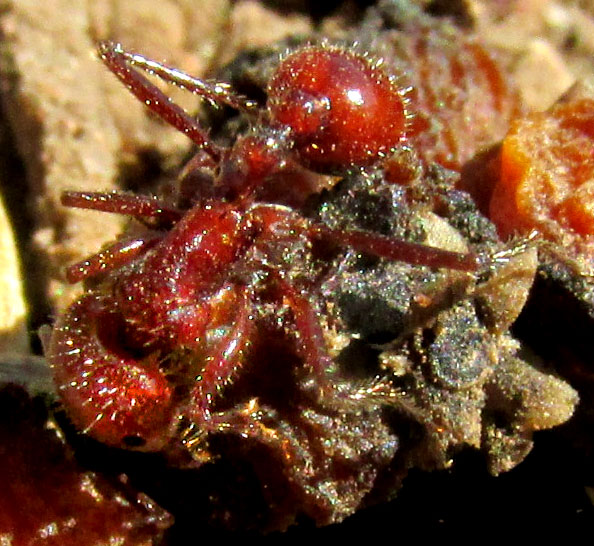
In the picture the ant is atop the fruit, apparently trying to remove the dried, hard flesh. In the pictured area, no ant was trying to move a fruit. The line of fruits ended at an ankle-high shelf of bedrock outcropping in their path upslope. Only very few dried fruits had made it over that shelf, and ants were trying to move them toward the nest, albeit with no success I could see, as shown below:
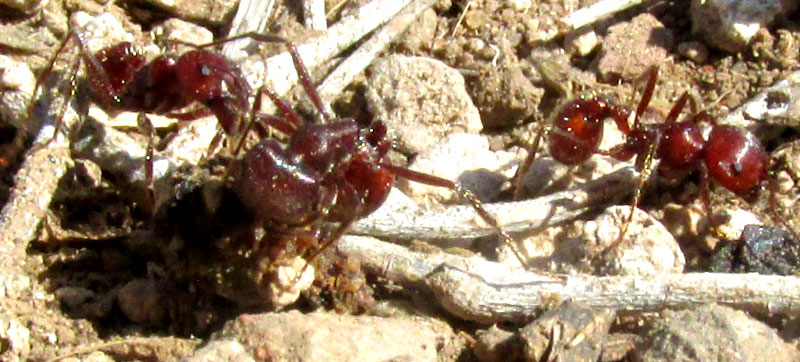
My best guess is that the ant is the Red Harvester Ant, Pogonomyrmex barbatus, distributed from arid Arizona east to Oklahoma and Texas, south in the arid uplands of Mexico to Oaxaca. In the past I've seen such trails of dried, seed-bearing segments of mesquite pods.